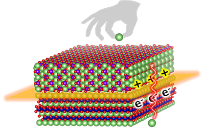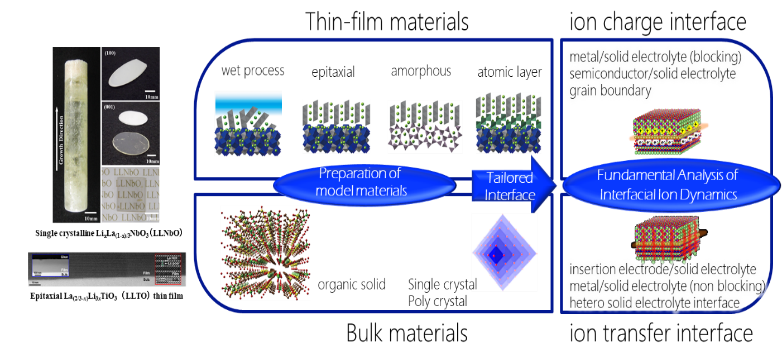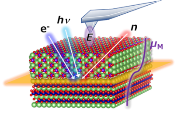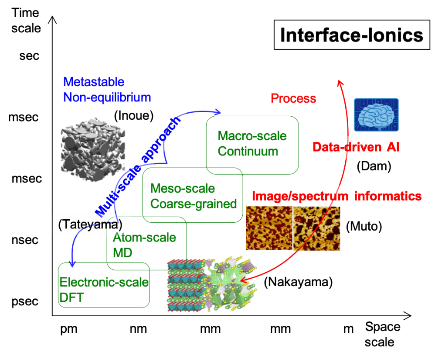Model Interface (Gp-A01)
 Gp-A01 develops model interface systems such as electrode/solid electrolyte interfaces, inorganic/organic solid electrolyte interfaces, and grain boundaries. Interfacial ion dynamics play important roles in the design of solid-state ionics devices such as all-solid-state batteries and capacitors. Gp-A01 uses thin-film technologies (e.g., pulsed laser deposition, atomic layer deposition, and sputtering) and single crystalline materials, among others, to develop model interfaces as well as investigate their interfacial ion transfer and ion accumulation properties using electrochemical methods. The resultant model interfaces are analyzed in Gp-A02.
Gp-A01 develops model interface systems such as electrode/solid electrolyte interfaces, inorganic/organic solid electrolyte interfaces, and grain boundaries. Interfacial ion dynamics play important roles in the design of solid-state ionics devices such as all-solid-state batteries and capacitors. Gp-A01 uses thin-film technologies (e.g., pulsed laser deposition, atomic layer deposition, and sputtering) and single crystalline materials, among others, to develop model interfaces as well as investigate their interfacial ion transfer and ion accumulation properties using electrochemical methods. The resultant model interfaces are analyzed in Gp-A02.

Advanced Analysis (Gp-A02)
 Unique ion transport/storage phenomena at solid-state interfaces are often attributed to anomalous physical/chemical states modulated locally at interfaces. Gp-A02 comprehensively reveals the physical/chemical characteristics of anomalous and local states such as ion concentration, electric/chemical/electrochemical potentials, micro/local structures, strain/distortion, and ion diffusion from multiple viewpoints by combining various novel and advanced analytical techniques. Through systematic analyses of Gp-A01’s and Gp‐A04’s model interfaces together with Gp‐A03’s theoretical calculaon, scientific principles to design high performance solid-state interfaces are established based on theoretical rationales.
Unique ion transport/storage phenomena at solid-state interfaces are often attributed to anomalous physical/chemical states modulated locally at interfaces. Gp-A02 comprehensively reveals the physical/chemical characteristics of anomalous and local states such as ion concentration, electric/chemical/electrochemical potentials, micro/local structures, strain/distortion, and ion diffusion from multiple viewpoints by combining various novel and advanced analytical techniques. Through systematic analyses of Gp-A01’s and Gp‐A04’s model interfaces together with Gp‐A03’s theoretical calculaon, scientific principles to design high performance solid-state interfaces are established based on theoretical rationales.

Computational & Data Science (Gp-A03)

To construct a theory for “Interface IONICS,” Gp-A03 introduces two strategies: computational and data science approaches. For the former, equilibrium/steady states and dynamics of electrons and ions around solid-solid interfaces are investigated using multiscale computational approaches through DFT (density functional theory) level calculations and continuum models. In addition, data-driven AI science approaches are implemented to elucidate large-scale structure-property relations in the observed images and spectra. Through these findings and deep collaborations with the other groups (A01, A02, and A04), a new theoretical framework for “Interface IONICS” is established.

Schematic picture of the A03 approaches
Design of Functional Interface (Gp-A04)

Gp-A04 studies solid-state ionics materials and realizes new functionalities through interface engineering. For instance, charge accumulation and migration of charge carriers are highly dependent on the interface structures of materials. Nevertheless, the origin is not clearly understood. One example of an electrode material for lithium storage is LiMnO2. Although LiMnO2 prepared by a conventional route shows an insufficient ability for charge accumulation, LiMnO2 with enriched grain boundaries shows a much better functionality as an electrode material. Gp-A04 establishes the basic science related to the interface structures of solid-state ionics materials, which will be the foundation for innovative solid-state energy storage systems and other functional solid-state devices.


